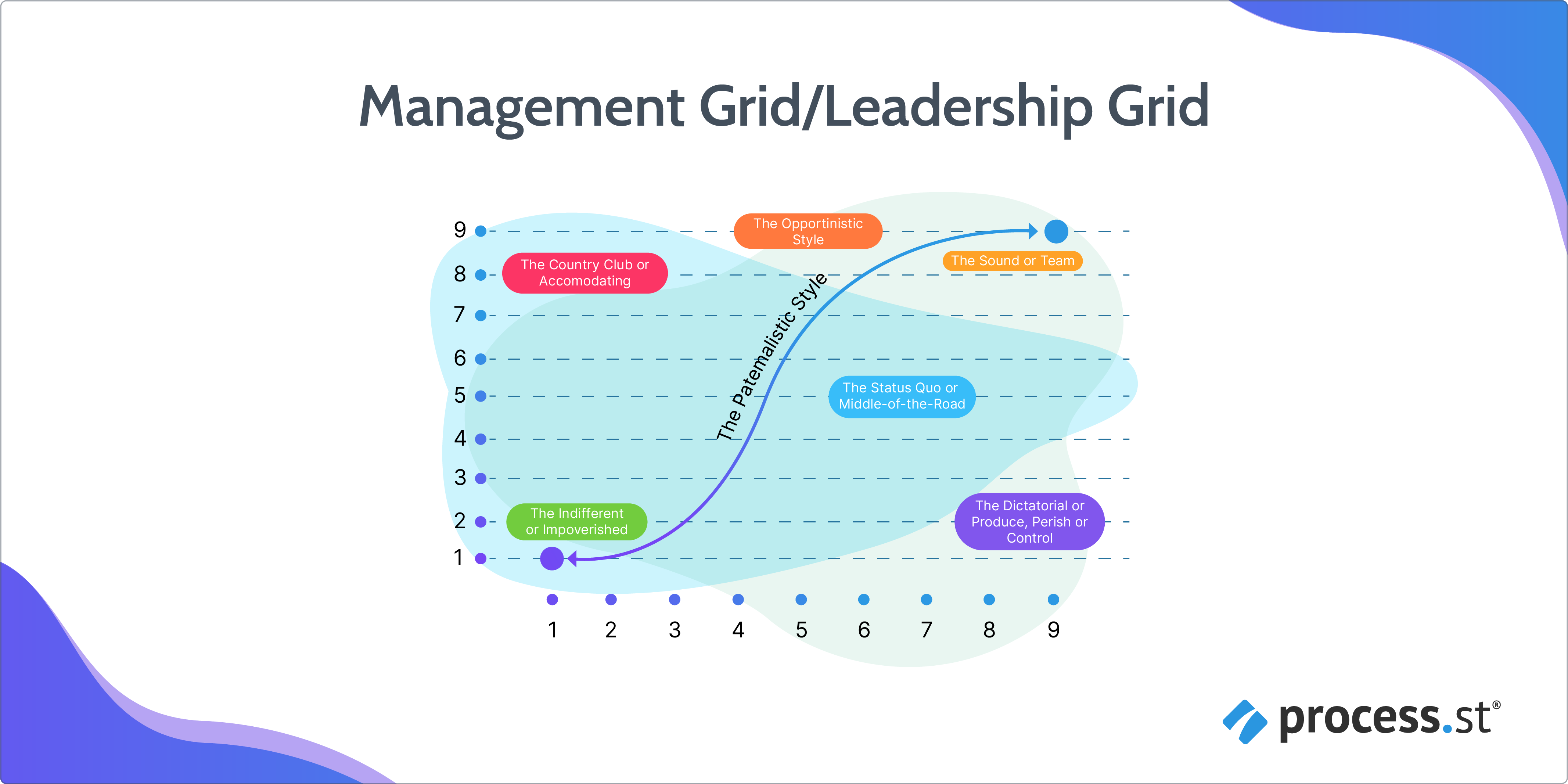
“I realized I had a challenge… [people] didn’t think they needed to be trained as a leader.
I realized I had a real uphill battle because people thought leadership was a noun.”
– John C. Maxwell, John C. Maxwell Defines Leadership
Not all leaders can lead effectively.
You might be a manager in name but that won’t inherently make your team like you, respect you, or do what you tell them to.
That’s why today I’ll show you the 10 main schools of thought for the behavioral theory of leadership.
By the end of this post, you’ll be able to identify what kind of leader you are, what kind of leader you want to be, and how to bridge that gap through your behavior.
If you’d rather skip to a particular section, go ahead and use the links below:
- What is the behavioral theory of leadership?
- The 10 types of behavioral leader
- The skills and behaviors of effective leaders
- How to build your leadership style into your processes
There’s also a free process template based on Ray Dalio’s methods up for grabs, so let’s get started.
What is the behavioral theory of leadership?
We’ve all heard the phrase “great leaders are born, not made”. This was the core of the original idea behind what made an effective leader.
After its proposal in the mid-1800s by Thomas Carlyle, trait theory (or the “great man” theory) of leadership served as one of the most widespread ideas on what makes a great leader.
I could name countless examples of why this seems ridiculous. A person’s nurture and what they do with their life plays such a pivotal role in their ability to fit a certain role that the theory seems incredibly close-minded but, alas, that was the dominant theory.
Then trait theory was tested and studied. It was discovered, measurably so, that are few natural traits that differentiate leaders from followers.
In other words, leaders are made, not born.

A new approach was needed. Enter the behavioral theory of leadership.
The idea is simple. If there are few natural traits exclusive to effective leaders, perhaps leaders aren’t born – they’re made.
Following this logic, if leaders are made, there must be some consistencies in the environment and behaviors that the individual is exposed to and learns to adopt. This, in theory, means that anyone could become a great leader if they were taught the same behaviors.
According to this theory, it isn’t inherent characteristics that make a good leader. A leader makes themselves effective via the way they act and what they do.
The 10 types of behavioral leader
Over the years of study and testing, the behavioral theory of leadership has highlighted many different types of leader through their actions.
While I won’t cover all 81+ of them (more on that later) I will highlight 10 of the most prominent types of leaders through their behaviors.
These are:
- Task-oriented leaders
- People-oriented leaders
- Participative (democratic) leadership
- Indifferent (impoverished) leaders
- Country club leaders
- Status-quo leaders
- Dictatorial leaders
- Sound (team) leaders
- Opportunistic style (OPP)
- Paternalistic style
Task-oriented leaders
The Leaders Behavior Description Questionnaire (LBDQ) was the result of a study by Ohio State University in the 1940s. They gave the questionnaire to groups ranging from college students to administrators and private companies to military personnel.
The goal? To find common leadership behaviors.
They found that two behavioral groups, in particular, were commonly related to effective leadership, these being task-oriented leaders and people-oriented leaders.
Task-oriented leaders are primarily concerned with the systems and structure that lets their team carry out their work. This includes everything from task descriptions to standard operating procedures, organizational and team structure, communication lines, and so on.
Key to remember here is that task-oriented leaders don’t ignore their employees as humans. They’re still concerned with motivating their team despite their primary focus being on systems.
Task-oriented leaders exhibit the following behaviors:
- Initiating
- Organizing
- Clarifying
- Information gathering
People-oriented leaders
The other group identified as a result of the LBDQ was people-oriented leaders.
Unlike task-oriented leaders, this group puts more effort into seeing to the human needs of their team and motivating them through that. It’s not that they don’t focus on the task or system, they just put more time and behavioral focus on their team as people with wants and needs.

For example, let’s say that your team is having a problem. Someone hasn’t managed to get their work done on time.
A task-oriented leader would dive into your processes to see if the problem could be prevented in the future or whether an SOP wasn’t followed properly. A people-oriented leader would behave differently, going straight to the employee and asking if there was any way they could help and what caused the problem.
People-oriented leaders exhibit the following behaviors:
- Encouraging
- Observing
- Listening
- Coaching and mentoring
Participative (democratic) leadership
In the 1950s Dr. Rensis Likert lead a study at the University of Michigan attempting to find characteristics (behaviors) of effective leadership.
He found three common behaviors. The first two backed up the LBDQ findings to show that task-oriented and people-oriented leaders are common effective examples. The third they identified was that of participative (also known as “democratic”) leadership.
As the name suggests, participative leaders are those who consult their entire team when creating systems and methods for achieving the team’s goals.
This means that work becomes much more collaborative, allowing the entire team to take part ownership of their work and the procedures behind it. This, in turn, means that they will be more motivated to carry out your processes more consistently and accurately.
By including the team in the decision-making process you help them to understand their work, why it matters, and motivate them to take appropriate action.
One of the biggest benefits of this behavioral leadership theory is that it allows the team to take advantage of everyone’s strengths.
Every team member’s voice is heard, encouraging creativity and engagement. It also provides an avenue for new leaders to show their abilities and for everyone to make the most of each others’ strengths.
This encourages communication and collaboration, which can often lead to a thriving company culture.
The downside is that participative leadership takes much more time than other methods. Having to speak to everyone means that there will be a much greater delay before action is taken.
Participative leaders exhibit the following behaviors:
- Communicating
- Collaborating
- Being open to feedback
- Encouraging
- Delegating
Indifferent (impoverished) leaders
In 1964 Dr. Robert Blake and Dr. Jane Mouton published the Managerial Grid Model (or “Leadership Grid”) in the first edition of The Managerial Grid. A result of their studies at Exxon, this grid identified five types of behavioral leaders and arranged them into a grid to demonstrate a more flexible scale of leadership behaviors and priorities.

The grid measures leadership styles against their concern for people (on the y-axis) and their concern for production (on the x-axis). In other words, they studied what behaviors and motivations create leaders and provided a system with which we can contextualize them.
While this presents 81 possibilities (with nine points on each axis), The Managerial Grid Model originally identified five models. Two more being added as the years went on.
The first of these is the indifferent or impoverished leader.
This is the leader that no-one wants to be.
These leaders are the most ineffective as they display behavior entirely dedicated to preserving their position and department from scrutiny. This will usually manifest in having very little contact with their team, dodging tasks wherever possible, putting severe pressure on their team to meet targets no matter the cost, and so on.
As such they’re at the lowest point of the Managerial Grid Model – they have little concern for the people under their care or the production of their team. As long as they keep their job, they don’t care.
They’re all the way down at the (1,1) point of the grid.
This is a bad leadership style to adopt, as it results in employee dissatisfaction, a nonexistent team culture, a high turnover rate, and very little productive work getting done.
Indifferent leaders exhibit the following behaviors:
- Evading
- Procrastinating
- Lack of communication
- Self-preservation
Country club leaders
Country club leaders were also identified in the Managerial Grid Model. Unlike indifferent leaders, these are people who put every effort into making sure that the human elements of their team are happy and satisfied.
As such, they sit at the (1,9) point of the Managerial Grid.
The theory is that a happy team will naturally produce better results, so a leader putting their efforts into making their team happy will naturally see success.
This isn’t a terrible behavioral theory of leadership, as it often leads to happy teams and a healthy company culture. Burnout will be low, leading to a lower turnover rate and reduced hiring costs.
Sadly, their lack of focus on productivity means that the team’s output often suffers as a result.
There’s a balance that needs to be stuck between caring for people and caring for results. Country club leadership does this better than indifferent leadership but still doesn’t quite reach the mark.
Country club leaders exhibit the following behaviors:
- Caring
- Listening to feedback
- Focus on employee health and happiness
- Quick to support employees
- Involved with the team
Status-quo leaders
Status-quo leaders are what you likely (hopefully) think of as a typical manager. They run the middle road of employee happiness and satisfaction and getting results.
Unfortunately, as shown by their position at (5,5) on the Managerial Grid, these leaders don’t fulfill either focus to its true potential.
They get more done than country club leaders. They focus on people more than indifferent leaders.
They can’t do either to full effectiveness.

This leaves their team at a middle ground emotionally. They aren’t particularly engaged with their work but neither are they so out of tune that they’d sooner quit than collect a paycheck – the same is true of their output.
Their behavior as such will cause this through attempts to engage employees and get good work out of them. These attempts will often be either half-hearted, inexperienced, or lack due consideration for the team members involved, resulting in the disconnect.
Status quo leaders exhibit the following behaviors:
- Listening to feedback
- Reasonable task distribution
- Lack of flexibility in task alterations
Dictatorial leaders
Dictatorial leaders are, as the name suggests, entirely focused on producing results without worry for the people under their employ.
A good example of this is the idea of developer “crunch” periods.
These are times where employees are pressured (if not outright forced) to work long stints to meet deadlines which are usually unreasonable at the expense of their own health and work-life balance.
As a result of their dogged pursuit of productivity at the expense of employees, turnover rates are usually high. These leaders are often seen in teams where burnout is frequent and replacements are common.
They take the (9,1) spot on the Managerial Grid.
Dictatorial leaders exhibit the following behaviors:
- Focus on productivity
- Non-acceptance of excuses
- Doesn’t listen to feedback
- Deadlines are absolute
- Hits their targets
Sound (team) leaders
Sound leaders are the utopia of leadership, and thus are almost more of an aspirational goal to strive to than something which is universally achievable.
These leaders are as focused on results as they are on the happiness and sustainability of their team.
This is why they are placed at the (9,9) spot on the Managerial Grid.
They can motivate people with both words and actions, they set goals which are high yet achievable, they thrive in their team’s culture and are open to discussing and working problems through to the satisfaction of all parties.
This plays into Douglas McGregor’s Y theory of management. He states that these managers believe people take pride in their work and are willing to rise to the challenge, benefitting more from autonomy and ownership of their own work.
Such a positive relationship with employees motivates them to reach their goals when guided appropriately.
If they are lacking skills, the sound leader will tutor them or give resources to allow them to expand their repertoire. Regular meetings and performance appraisals are regular but the focus is on encouragement rather than picking faults.
The cornerstones of this leadership style are communication and collaboration. Without appropriate connections to their team it will prove hard, if not impossible, to allow them to reliably take their workload into their own hands.
Sound leaders exhibit the following behaviors:
- Constant communication
- Allowing employees autonomy and ownership of tasks
- Encouragement
- Listening to (and enacting) feedback
- Provision of resources to further employees’ skills
Opportunistic style (OPP)

The final two leadership styles shown in the Managerial Grid are more flexible than the previous entries. Due to this, they don’t have a set numerical entry on the grid.
The opportunistic style of leadership can take the form of any of the previous five styles and positions on the grid.
These leaders adjust their approach based on what will most effectively achieve their goals. While this isn’t inherently a bad thing, it does mean that the output and happiness of their team is much more variable than a consistent sound leadership style.
Think of it as “the end justifies the means”.
If the team is doing fine but deadlines are fast approaching, a dictatorial style will be adopted to hit those marks. Coming out of the crunch they may act as a country club leader to let their team recuperate, and so on.
Opportunistic leaders exhibit the following behaviors:
- Lack of consistent leadership style
- Pushing to meet goals no matter the cost
- Listening when beneficial to them
- Caring for the team solely to prevent roadblocks
Paternalistic style
The paternalistic style of leadership is the other side of the coin to the opportunistic style.
These leaders also focus on the end results of their team but are much more flexible in their approach, rewarding good performance and setting goals for themselves and others.
As such, their leadership style can be anywhere from (9,1) to (1,9) on the managerial grid.
They value their team members and their skills, providing opportunities and resources to better their education and standing.
However, they tend to be critical of thinking that opposes their own.
Think of them like a stern, but fair, parent. They reward success but are relatively intolerant of failure.
Paternalistic leaders exhibit the following behaviors:
- Supporting employees in increasing their skills
- Doesn’t listen to feedback
- Rewards success and punishes failure
The skills and behaviors of effective leaders
So there you have it – the prevailing behavioral theories of leadership. This is where most would sign off without another word but that’s not how we like to do things here at Process Street.
We like to give you actionable tips for you to use.
As such, let’s break down some of the more effective leadership theories highlighted above to demonstrate the kind of skills and actions involved. These both contribute to the behavior of you as a leader, shaping the kind of management you present.
Drawing from the styles above, we can see that effective behaviors include:
- Listening to feedback
- Encouraging communication
- Providing support for employees to improve
- Giving autonomy to employees
- Managing deadlines to be realistic
- Assigning tasks based on individual skills and interests
- Knowing and reiterating clear goals and team mission statement
- Consistent and frequent meetings with employees to assess and give feedback
- Motivating employees to work with and without you
- Meeting goals
- Building and maintaining a healthy team/company culture
To display these behaviors you’ll need to have the following skills:
- Extensive knowledge of your topic
- Being approachable to all levels of employee
- Solid time management
- Effective task prioritization
- Flexible planning
- Ability to empathize with your team
How to build your leadership style into your processes
Ray Dalio is an incredibly successful investor and hedge fund manager.
His theory of leadership aligns closely with that of the dictatorial leader, believing that visionary leaders can only be successful by focusing on their vision above all others and being intolerant of those who aren’t excellent at their job.
With such a focus on the individual’s priorities and methods, you’d think it hard to maintain that level of dedication and drive. It is.
However, one of the best ways to support this and all other forms of effective leadership is to build your regular processes around those behaviors and ideals.
The best way to do this is with Process Street – the best piece of BPM software on the market.
By building your ideal behavior into a repeatable, consistent process checklist you ensure that things are done correctly every time and meet your high standards.
Don’t know where to start? No worries! We have a library of premade process templates which you can use at the click of a button. Here’s a sample:
Click here to sign up for a free Process Street account today.
What behavior do you think makes for a good leader? Let me know in the comments below!







 Workflows
Workflows Projects
Projects Data Sets
Data Sets Forms
Forms Pages
Pages Automations
Automations Analytics
Analytics Apps
Apps Integrations
Integrations
 Property management
Property management
 Human resources
Human resources
 Customer management
Customer management
 Information technology
Information technology



Ben Mulholland
Ben Mulholland is an Editor at Process Street, and winds down with a casual article or two on Mulholland Writing. Find him on Twitter here.